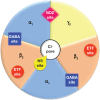Anxiety disorders and GABA neurotransmission: a disturbance of modulation
- PMID: 25653526
- PMCID: PMC4303399
- DOI: 10.2147/NDT.S58841
Anxiety disorders and GABA neurotransmission: a disturbance of modulation
Abstract
Lines of evidence coming from many branches of neuroscience indicate that anxiety disorders arise from a dysfunction in the modulation of brain circuits which regulate emotional responses to potentially threatening stimuli. The concept of anxiety disorders as a disturbance of emotional response regulation is a useful one as it allows anxiety to be explained in terms of a more general model of aberrant salience and also because it identifies avenues for developing psychological, behavioral, and pharmacological strategies for the treatment of anxiety disorder. These circuits involve bottom-up activity from the amygdala, indicating the presence of potentially threatening stimuli, and top-down control mechanisms originating in the prefrontal cortex, signaling the emotional salience of stimuli. Understanding the factors that control cortical mechanisms may open the way to identification of more effective cognitive behavioral strategies for managing anxiety disorders. The brain circuits in the amygdala are thought to comprise inhibitory networks of γ-aminobutyric acid-ergic (GABAergic) interneurons and this neurotransmitter thus plays a key role in the modulation of anxiety responses both in the normal and pathological state. The presence of allosteric sites on the GABAA receptor allows the level of inhibition of neurons in the amygdala to be regulated with exquisite precision, and these sites are the molecular targets of the principal classes of anxiolytic drugs. Changes in the levels of endogenous modulators of these allosteric sites as well as changes in the subunit composition of the GABAA receptor may represent mechanisms whereby the level of neuronal inhibition is downregulated in pathological anxiety states. Neurosteroids are synthesized in the brain and act as allosteric modulators of the GABAA receptor. Since their synthesis is itself regulated by stress and by anxiogenic stimuli, targeting the neurosteroid-GABAA receptor axis represents an attractive target for the modulation of anxiety.
Keywords: allosteric modulation; amygdala; neurosteroids; salience; γ-aminobutyric acid.
Figures




Similar articles
-
GABAergic implications in anxiety and related disorders.Biochem Biophys Res Commun. 2024 Sep 10;724:150218. doi: 10.1016/j.bbrc.2024.150218. Epub 2024 Jun 3. Biochem Biophys Res Commun. 2024. PMID: 38865810 Review.
-
Rescue of deficient amygdala tonic γ-aminobutyric acidergic currents in the Fmr-/y mouse model of fragile X syndrome by a novel γ-aminobutyric acid type A receptor-positive allosteric modulator.J Neurosci Res. 2016 Jun;94(6):568-78. doi: 10.1002/jnr.23632. Epub 2015 Aug 26. J Neurosci Res. 2016. PMID: 26308557 Free PMC article.
-
GABAergic and dopaminergic transmission in the rat cerebral cortex: effect of stress, anxiolytic and anxiogenic drugs.Pharmacol Ther. 1990;48(2):121-42. doi: 10.1016/0163-7258(90)90077-f. Pharmacol Ther. 1990. PMID: 1981393 Review.
-
GABAA receptor modulation by neurosteroids in models of temporal lobe epilepsies.Epilepsia. 2012 Dec;53 Suppl 9:89-101. doi: 10.1111/epi.12038. Epilepsia. 2012. PMID: 23216582 Review.
-
Developmentally regulated neurosteroid synthesis enhances GABAergic neurotransmission in mouse thalamocortical neurones.J Physiol. 2015 Jan 1;593(1):267-84. doi: 10.1113/jphysiol.2014.280263. Epub 2014 Dec 3. J Physiol. 2015. PMID: 25556800 Free PMC article.
Cited by
-
Modulatory effects of dynamic fMRI-based neurofeedback on emotion regulation networks in adolescent females.Neuroimage. 2020 Oct 15;220:117053. doi: 10.1016/j.neuroimage.2020.117053. Epub 2020 Jun 20. Neuroimage. 2020. PMID: 32574803 Free PMC article.
-
Chemogenetic Modulation of Orexin Neurons Reverses Changes in Anxiety and Locomotor Activity in the A53T Mouse Model of Parkinson's Disease.Front Neurosci. 2019 Jul 30;13:702. doi: 10.3389/fnins.2019.00702. eCollection 2019. Front Neurosci. 2019. PMID: 31417337 Free PMC article.
-
Effects of Ficus umbellata (Moraceae) Aqueous Extract and 7-Methoxycoumarin on Scopolamine-Induced Spatial Memory Impairment in Ovariectomized Wistar Rats.Behav Neurol. 2018 Sep 30;2018:5751864. doi: 10.1155/2018/5751864. eCollection 2018. Behav Neurol. 2018. PMID: 30363978 Free PMC article.
-
Repeated social defeat stress exacerbates lipopolysaccharide-induced behavioural deficits in mice: ameliorative role of Chrysophyllum albidum fruit extract through anti-neuroinflammation, antioxidant and neurochemical balance.Metab Brain Dis. 2022 Oct;37(7):2467-2481. doi: 10.1007/s11011-022-01053-x. Epub 2022 Jul 22. Metab Brain Dis. 2022. PMID: 35867181
-
The Epigenetics of Anxiety Pathophysiology: A DNA Methylation and Histone Modification Focused Review.eNeuro. 2023 Apr 24;10(4):ENEURO.0109-21.2021. doi: 10.1523/ENEURO.0109-21.2021. Print 2023 Apr. eNeuro. 2023. PMID: 35998298 Free PMC article. Review.
References
-
- Uhlenhuth EH, Starcevic V, Warner TD, et al. A general anxiety-prone cognitive style in anxiety disorders. J Affect Disord. 2002;70(3):241–249. - PubMed
-
- Ganellen RJ, Matuzas W, Uhlenhuth EH, Glass R, Easton CR. Panic disorder, agoraphobia, and anxiety-relevant cognitive style. J Affect Disord. 1986;11(3):219–225. - PubMed
-
- Starcevic V, Sammut P, Berle D, et al. Can levels of a general anxiety-prone cognitive style distinguish between various anxiety disorders? Compr Psychiatry. 2012;53(5):427–433. - PubMed
-
- American Psychiatric Association . Diagnostic and Statistical Manual of Mental Disorders, Fourth Edition – Text Revision: DSM-IV-TR®. Arlington, VA: American Psychiatric Association; 2000.
-
- American Psychiatric Association . Diagnostic and Statistical Manual of Mental Disorders, Fifth Edition: DSM-V®. Arlington, VA: American Psychiatric Association; 2013.
Publication types
LinkOut - more resources
Full Text Sources
Other Literature Sources

